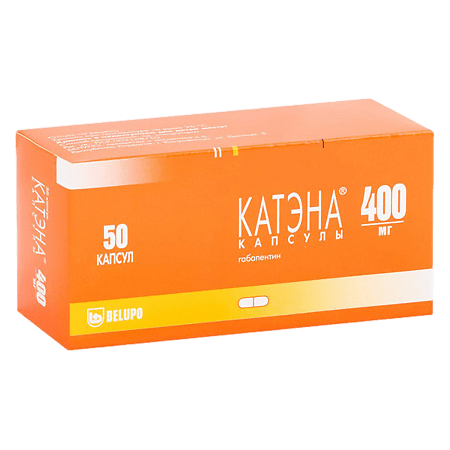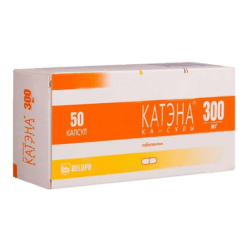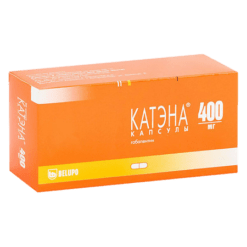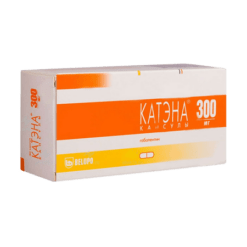No products in the cart.
Catena, 400 mg capsules 50 pcs
€33.85 €29.33
Description
A anticonvulsant drug. Gabapentin is similar in structure to the neurotransmitter GABA (GABA), but still its mechanism of action differs from some other similar drugs that interact with GABA receptors, including valproate, barbiturates, benzodiazepines, GABA transaminase inhibitors, GABA capture inhibitors, GABA agonists and prodrug forms of GABA: it has no GABAergic properties and has no effect on GABA capture and metabolism.
The results of preliminary studies have shown that gabapentin binds to the α2-δ-subunit of voltage-dependent calcium channels and suppresses calcium ion flux, which plays an important role in causing neuropathic pain.
The other mechanisms involved in the action of gabapentin in neuropathic pain are: reduction of glutamate-dependent neuronal death, increase in GABA synthesis, suppression of monoamine group neurotransmitter release.
Gabapentin in clinically relevant concentrations does not bind to receptors of other common drugs or neurotransmitters, including GABAA, GABAB, benzodiazepine, glutamate, glycine or N-methyl-D-aspartate receptors.
Unlike phenytoin and carbamazepine, gabapentin does not interact with sodium channels.
Indications
Indications
treatment of neuropathic pain in adults (18 years and older). Efficacy and safety in patients under 18 years of age have not been established;
monotherapy for partial seizures in epilepsy with and without secondary generalization in adults and children over 12 years of age. The effectiveness and safety of monotherapy in children under 12 years of age have not been established;
as an additional agent in the treatment of partial seizures in epilepsy with and without secondary generalization in adults and children aged 3 years and older. The safety and effectiveness of adjunctive gabapentin therapy in children less than 3 years of age have not been established.
Pharmacological effect
Pharmacological effect
Anticonvulsant drug. Gabapentin is structurally similar to the neurotransmitter GABA (GABA), but its mechanism of action differs from some other similar drugs that interact with GABA receptors, including valproate, barbiturates, benzodiazepines, GABA transaminase inhibitors, GABA uptake inhibitors, GABA agonists and prodrugs of GABA: it does not have GABAergic properties and does not affect GABA uptake and metabolism.
Preliminary studies have shown that gabapentin binds to the α2-δ subunit of voltage-gated calcium channels and inhibits the flow of calcium ions, which plays an important role in neuropathic pain.
Other mechanisms involved in the action of gabapentin in neuropathic pain are: a decrease in glutamate-dependent neuronal death, an increase in the synthesis of GABA, and a suppression of the release of monoamine neurotransmitters.
Gabapentin at clinically relevant concentrations does not bind to receptors for other common drugs or neurotransmitters, including GABAA, GABAB, benzodiazepine, glutamate, glycine, or N-methyl-D-aspartate receptors.
Unlike phenytoin and carbamazepine, gabapentin does not interact with sodium channels.
Special instructions
Special instructions
When combined with morphine, patients may experience an increase in gabapentin concentrations. In this case, it is necessary to carefully monitor patients for the development of such a sign of CNS depression as drowsiness. In this case, the dose of gabapentin or morphine should be adequately reduced.
False-positive results have been reported when gabapentin and other anticonvulsants were used concomitantly with Ames N-Multistix SG® urinary protein test strips. To determine protein in urine, it is recommended to use the more specific method of precipitation with sulfosalicylic acid.
Impact on the ability to drive vehicles and operate machinery
During the treatment period, it is necessary to refrain from driving vehicles and engaging in potentially hazardous activities that require increased concentration and speed of psychomotor reactions.
Active ingredient
Active ingredient
Gabapentin
Composition
Composition
Composition of one capsule:
Pregnancy
Pregnancy
There are no data on the safety and effectiveness of the drug during pregnancy, so the use of gabapentin during pregnancy is possible only if the expected benefit to the mother justifies the possible risk to the fetus.
Gabapentin is excreted in breast milk, so breastfeeding should be avoided during treatment.
Use in children
Contraindicated in children under 3 years of age.
Contraindications
Contraindications
children under 3 years of age;
hypersensitivity to gabapentin or auxiliary components of the drug.
The drug should be prescribed with caution in case of renal failure.
Use for renal impairment
The drug should be prescribed with caution in case of renal failure.
For patients on hemodialysis who have not previously taken gabapentin, it is recommended to prescribe the drug at a loading dose of 300-400 mg, and then use it at 200-300 mg every 4 hours of hemodialysis.
Side Effects
Side Effects
From the cardiovascular system: symptoms of vasodilation, hypertension.
From the digestive system: dyspepsia, flatulence, nausea, vomiting, abdominal pain, constipation, diarrhea, dry mouth or pharynx, anorexia, gingivitis, dental diseases, increased appetite, increased activity of liver transaminases.
From the musculoskeletal system: myalgia, arthralgia, back pain, increased bone fragility.
From the nervous system: drowsiness, dizziness, ataxia, amnesia, confusion, lack of coordination, increased fatigue, impaired thinking, tremor, hypoesthesia, depression, dysarthria, insomnia, nervousness, nystagmus, increased, weakened or absent reflexes, asthenia, anxiety, hostility, hyperkinesia, emotional lability.
From the respiratory system: pharyngitis, rhinitis, shortness of breath, cough, pneumonia, bronchitis, respiratory infections.
From the genitourinary system: urinary tract infections, impotence.
From the senses: visual impairment, amblyopia, diplopia.
From the hematopoietic organs: leukopenia, purpura (most often it is described as bruising that occurs due to physical trauma).
Allergic reactions: skin rash, itching, acne.
Other: fever, viral infection, weight gain, pain of various localizations, peripheral edema, facial swelling, headache.
Post-registration experience of use
There have been cases of sudden unexplained death, the connection of which with gabapentin treatment has not been established.
Other adverse events: acute renal failure, allergic reactions, including urticaria, alopecia, angioedema, generalized edema; fluctuations in blood glucose concentrations in patients with diabetes mellitus, chest pain, enlargement of the mammary glands, gynecomastia, increased liver function tests, erythema multiforme (including Stevens-Johnson syndrome), hallucinations, movement disorders such as choreoathetosis, dyskinesia and dystonia, palpitations, pancreatitis, tinnitus, thrombocytopenia, urinary incontinence, myoclonus.
Interaction
Interaction
When gabapentin and morphine were coadministered, when morphine was taken 2 hours before gabapentin, there was a 44% increase in mean gabapentin AUC compared to gabapentin monotherapy, which was associated with an increase in pain threshold (cold pressor test). The clinical significance of this change has not been established; the pharmacokinetic characteristics of morphine did not change. The side effects of morphine when taken together with gabapentin did not differ from those when morphine was taken together with placebo.
No interactions were observed between gabapentin and phenobarbital, phenytoin, valproic acid and carbamazepine. The pharmacokinetics of gabapentin at steady state are similar in healthy subjects and patients receiving other anticonvulsants.
Concomitant use of gabapentin with oral contraceptives containing norethisterone and/or ethinyl estradiol was not accompanied by changes in the pharmacokinetics of both components.
The simultaneous use of gabapentin with antacids containing aluminum and magnesium is accompanied by a decrease in the bioavailability of gabapentin by approximately 20%. It is recommended to take gabapentin approximately 2 hours after taking the antacid.
Probenecid does not affect the renal excretion of gabapentin.
The slight decrease in renal excretion of gabapentin with concomitant use of cimetidine is probably not clinically significant.
Overdose
Overdose
Symptoms: dizziness, double vision, speech impairment, drowsiness, lethargy and diarrhea.
Treatment: gastric lavage, taking activated carbon, symptomatic therapy. Hemodialysis may be indicated for patients with severe renal impairment.
Functional features
Functional features
Suction
The bioavailability of gabapentin is not proportional to the dose; as the dose increases, it decreases. After oral administration, Cmax of gabapentin in plasma is achieved within 2-3 hours. The absolute bioavailability of gabapentin in capsules is about 60%. Food, incl. with a high fat content, has no effect on pharmacokinetics. The clearance of gabapentin from plasma is best described by a linear model.
Distribution
Pharmacokinetics does not change with repeated use. Plasma Css can be determined based on the results of a single dose of the drug. Gabapentin practically does not bind to plasma proteins (d – 57.7 l.
Metabolism
No signs of metabolism were found in humans.
The drug does not induce mixed-function oxidative liver enzymes involved in drug metabolism.
Removal
T1/2 of plasma does not depend on the dose and averages 5-7 hours. It is excreted exclusively by the kidneys in unchanged form.
Pharmacokinetics in special clinical situations
Plasma clearance of gabapentin is reduced in the elderly and patients with impaired renal function. The elimination rate constant, plasma clearance, and renal clearance are directly proportional to creatinine clearance. Gabapentin is removed from plasma during hemodialysis. In patients with impaired renal function and patients receiving hemodialysis treatment, dose adjustment is recommended.
Gabapentin plasma concentrations in children aged 4 to 12 years have been found to be generally similar to those in adults.
Storage conditions
Storage conditions
At a temperature not exceeding 25 °C
Shelf life
Shelf life
3 years
Manufacturer
Manufacturer
Belupo, medicines and cosmetics d.d., Croatia
Additional information
| Shelf life | 3 years |
|---|---|
| Conditions of storage | At a temperature not exceeding 25 °C |
| Manufacturer | Belupo,medicines and cosmetics d.d., Croatia |
| Medication form | capsules |
| Brand | Belupo,medicines and cosmetics d.d. |
Other forms…
Related products
Buy Catena, 400 mg capsules 50 pcs with delivery to USA, UK, Europe and over 120 other countries.

















